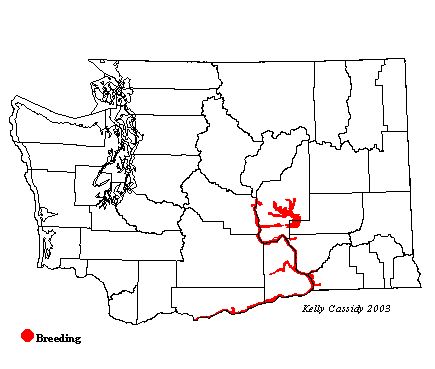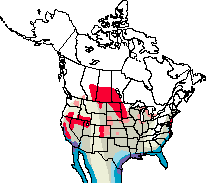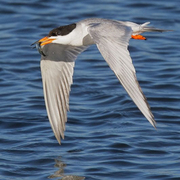Forster's Tern
The Washington representatives of this family can be split into two groups, or subfamilies. The adaptable gulls are the most familiar. Sociable in all seasons, they are mainly coastal, but a number of species also nest inland. Many—but not all—are found around people. Gulls have highly variable foraging techniques and diets. Terns forage in flight, swooping to catch fish or insects. They dive headfirst into the water for fish. Although they are likely to be near water, they spend less time swimming than gulls.
General Description
The Forster's Tern is similar looking to the Common Tern, but found in slightly different habitat. In breeding plumage, it has a light gray mantle with silvery-white primaries. Its long, light tail is deeply forked, and its undersides are all white. The wings appear very light, silvery gray in flight. It has a black cap, commonly found in terns. The bill is orange-red with a black tip, and the legs are orange-red'both more orange than those of the Common Tern. The adult in non-breeding plumage lacks the black cap. Black markings over the eyes, extending back to the ears, give the bird a distinctly masked look. The bill is black, and the wingtips are grayer than in breeding plumage. Juvenile birds have a significant amount of brown wash on their feathers, but this usually disappears by August.
Habitat
Forster's Terns typically inhabit fresh and saltwater marshes in the summer. During migration and in winter, they can be found in a wider variety of aquatic habitat, especially around estuaries, inlets, and bays, but rarely out of sight of land.
Behavior
The Forster's Tern flies and hovers over the water, plunging to take fish from just below the surface. It also forages for flying insects. This tern is aggressive towards other birds near its nest.
Diet
Fish make up the majority of the diet in all seasons, but in summer, insects are another major food source. Other aquatic creatures are also taken.
Nesting
Often nesting atop muskrat houses or on gravel islands, Forster's Terns form loose colonies and sometimes associate with Yellow-headed Blackbird colonies. When Forster's Terns and Black Terns nest in the same marsh, the Forster's Terns choose higher and drier ground for their nests. Both sexes help build the nest, a platform of reeds and grasses, with a hollowed-out center lined with finer materials and shells. Incubation of the 3 eggs is shared by both sexes for 23-25 days. The development of the young is not well known, but both parents help feed the young at the nest.
Migration Status
Forster's Terns are migratory, but to a lesser extent than Common Terns. They winter along the southern US coastline.
Conservation Status
Destruction of wetlands has led to declines in some areas. Recreational boating on nesting lakes, which can flood nests, may also have a negative impact on populations of Forster's Terns.
When and Where to Find in Washington
The Forster's Tern is found mostly east of the Cascades, although it has been recorded on the west side, often after August. It is common on freshwater habitat from May to mid-August in the Columbia Basin. It breeds from the Potholes region, south along the Columbia River to the Tri-cities area. It is also found farther up the Columbia, although less commonly, to Grant and Adams Counties, and west to Klickitat County.
 Abundance
Abundance
| Ecoregion | Jan | Feb | Mar | Apr | May | Jun | Jul | Aug | Sep | Oct | Nov | Dec |
|---|---|---|---|---|---|---|---|---|---|---|---|---|
| Oceanic | ||||||||||||
| Pacific Northwest Coast | ||||||||||||
| Puget Trough | ||||||||||||
| North Cascades | ||||||||||||
| West Cascades | ||||||||||||
| East Cascades | R | R | R | R | ||||||||
| Okanogan | ||||||||||||
| Canadian Rockies | ||||||||||||
| Blue Mountains | ||||||||||||
| Columbia Plateau | U | F | F | F | F | U |
Washington Range Map

North American Range Map


Family Members
 Laughing GullLarus atricilla
Laughing GullLarus atricilla Franklin's GullLarus pipixcan
Franklin's GullLarus pipixcan Little GullLarus minutus
Little GullLarus minutus Black-headed GullLarus ridibundus
Black-headed GullLarus ridibundus Bonaparte's GullLarus philadelphia
Bonaparte's GullLarus philadelphia Heermann's GullLarus heermanni
Heermann's GullLarus heermanni Black-tailed GullLarus crassirostris
Black-tailed GullLarus crassirostris Short-billed GullLarus canus
Short-billed GullLarus canus Ring-billed GullLarus delawarensis
Ring-billed GullLarus delawarensis California GullLarus californicus
California GullLarus californicus Herring GullLarus argentatus
Herring GullLarus argentatus Thayer's GullLarus thayeri
Thayer's GullLarus thayeri Iceland GullLarus glaucoides
Iceland GullLarus glaucoides Lesser Black-backed GullLarus fuscus
Lesser Black-backed GullLarus fuscus Slaty-backed GullLarus schistisagus
Slaty-backed GullLarus schistisagus Western GullLarus occidentalis
Western GullLarus occidentalis Glaucous-winged GullLarus glaucescens
Glaucous-winged GullLarus glaucescens Glaucous GullLarus hyperboreus
Glaucous GullLarus hyperboreus Great Black-backed GullLarus marinus
Great Black-backed GullLarus marinus Sabine's GullXema sabini
Sabine's GullXema sabini Black-legged KittiwakeRissa tridactyla
Black-legged KittiwakeRissa tridactyla Red-legged KittiwakeRissa brevirostris
Red-legged KittiwakeRissa brevirostris Ross's GullRhodostethia rosea
Ross's GullRhodostethia rosea Ivory GullPagophila eburnea
Ivory GullPagophila eburnea Least TernSternula antillarum
Least TernSternula antillarum Caspian TernHydroprogne caspia
Caspian TernHydroprogne caspia Black TernChlidonias niger
Black TernChlidonias niger Common TernSterna hirundo
Common TernSterna hirundo Arctic TernSterna paradisaea
Arctic TernSterna paradisaea Forster's TernSterna forsteri
Forster's TernSterna forsteri Elegant TernThalasseus elegans
Elegant TernThalasseus elegans

